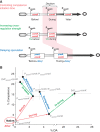Temporal competition between differentiation programs determines cell fate choice
- PMID: 22146301
- PMCID: PMC3737729
- DOI: 10.1038/msb.2011.88
Temporal competition between differentiation programs determines cell fate choice
Abstract
Multipotent differentiation, where cells adopt one of several possible fates, occurs in diverse systems ranging from bacteria to mammals. This decision-making process is driven by multiple differentiation programs that operate simultaneously in the cell. How these programs interact to govern cell fate choice is poorly understood. To investigate this issue, we simultaneously measured activities of the competing sporulation and competence programs in single Bacillus subtilis cells. This approach revealed that these competing differentiation programs progress independently without cross-regulation before the decision point. Cells seem to arrive at a fate choice through differences in the relative timing between the two programs. To test this proposed dynamic mechanism, we altered the relative timing by engineering artificial cross-regulation between the sporulation and competence circuits. Results suggest a simple model that does not require a checkpoint or intricate cross-regulation before cellular decision-making. Rather, cell fate choice appears to be the outcome of a 'molecular race' between differentiation programs that compete in time, providing a simple dynamic mechanism for decision-making.
Conflict of interest statement
The authors declare that they have no conflict of interest.
Figures





Comment in
-
Winner takes all in a race for cell fate.Mol Syst Biol. 2011 Dec 6;7:558. doi: 10.1038/msb.2011.92. Mol Syst Biol. 2011. PMID: 22146302 Free PMC article. No abstract available.
-
Differentiation: Racing to decide.Nat Rev Genet. 2011 Dec 20;13(2):72. doi: 10.1038/nrg3158. Nat Rev Genet. 2011. PMID: 22183154 No abstract available.
-
Bacterial development: Racing to decide.Nat Rev Microbiol. 2012 Jan 16;10(2):84. doi: 10.1038/nrmicro2735. Nat Rev Microbiol. 2012. PMID: 22245931 No abstract available.
Similar articles
-
Winner takes all in a race for cell fate.Mol Syst Biol. 2011 Dec 6;7:558. doi: 10.1038/msb.2011.92. Mol Syst Biol. 2011. PMID: 22146302 Free PMC article. No abstract available.
-
Programmed fluctuations in sense/antisense transcript ratios drive sexual differentiation in S. pombe.Mol Syst Biol. 2011 Dec 20;7:559. doi: 10.1038/msb.2011.90. Mol Syst Biol. 2011. PMID: 22186733 Free PMC article.
-
Global coordination of transcriptional control and mRNA decay during cellular differentiation.Mol Syst Biol. 2010 Jun 8;6:380. doi: 10.1038/msb.2010.38. Mol Syst Biol. 2010. PMID: 20531409 Free PMC article.
-
[RNA-protein complex that governs meiosis in fission yeast].Tanpakushitsu Kakusan Koso. 2006 Dec;51(16 Suppl):2443-9. Tanpakushitsu Kakusan Koso. 2006. PMID: 17471961 Review. Japanese. No abstract available.
-
Molecular mechanisms underlying the mitosis-meiosis decision.Chromosome Res. 2007;15(5):523-37. doi: 10.1007/s10577-007-1151-0. Chromosome Res. 2007. PMID: 17674143 Review.
Cited by
-
Noise in biology.Rep Prog Phys. 2014;77(2):026601. doi: 10.1088/0034-4885/77/2/026601. Epub 2014 Jan 20. Rep Prog Phys. 2014. PMID: 24444693 Free PMC article. Review.
-
Speed-dependent cellular decision making in nonequilibrium genetic circuits.PLoS One. 2012;7(3):e32779. doi: 10.1371/journal.pone.0032779. Epub 2012 Mar 13. PLoS One. 2012. PMID: 22427883 Free PMC article.
-
Stochastic timing in gene expression for simple regulatory strategies.Nucleic Acids Res. 2017 Feb 17;45(3):1069-1078. doi: 10.1093/nar/gkw1235. Nucleic Acids Res. 2017. PMID: 28180313 Free PMC article.
-
Maximization of information transmission influences selection of native phosphorelay architectures.PeerJ. 2021 Jun 10;9:e11558. doi: 10.7717/peerj.11558. eCollection 2021. PeerJ. 2021. PMID: 34178454 Free PMC article.
-
Chromosomal Arrangement of Phosphorelay Genes Couples Sporulation and DNA Replication.Cell. 2015 Jul 16;162(2):328-337. doi: 10.1016/j.cell.2015.06.012. Epub 2015 Jul 9. Cell. 2015. PMID: 26165942 Free PMC article.
References
-
- Asayama M, Kobayashi Y (1993) Signal transduction and sporulation in Bacillus subtilis: heterologous phosphorylation of Spo0A, a sporulation initiation gene product. J Biochem 114: 385–388 - PubMed
-
- Bai U, Mandic-Mulec I, Smith I (1993) SinI modulates the activity of SinR, a developmental switch protein of Bacillus subtilis, by protein-protein interaction. Genes Dev 7: 139–148 - PubMed
Publication types
MeSH terms
Substances
Grants and funding
LinkOut - more resources
Full Text Sources
Other Literature Sources

